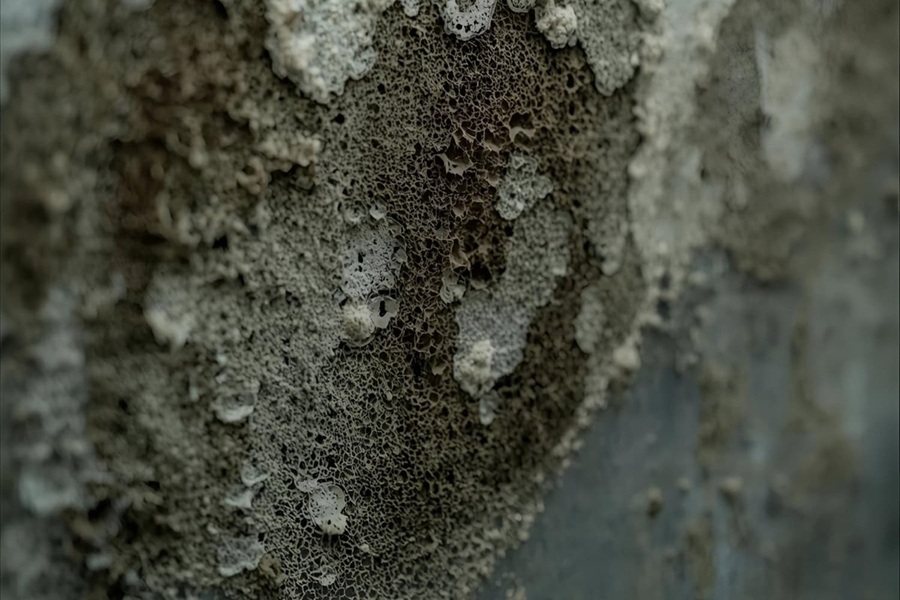Understanding and minimizing the risk of mould indoors
Mold growth in living spaces is a widespread problem that concerns many homeowners, tenants and building managers. Mold is ubiquitous in our environment and is usually harmless in low concentrations. However, under certain conditions, especially due to moisture, an increased risk of mold can quickly develop, which not only attacks the building fabric, but can also affect the health of the occupants. In this article, you will find out how mold develops, what risks it poses and how you can effectively assess and reduce your mold risk with a special reference to the practical mold-free index from air-Q.
How does mold develop?
Molds need moisture as the most important prerequisite for growth. This moisture can find its way indoors in various ways. One of the most common causes is condensation: when warm, moist air meets cold surfaces, water droplets form, providing the perfect breeding ground for mold. In addition, building defects such as leaking roofs, cracks in the masonry or defective water pipes encourage the ingress of moisture.
Incorrect user behavior also promotes mould growth. Insufficient ventilation, incorrect heating behavior or excessive humidity caused by cooking, showering or having lots of indoor plants can increase the humidity in the room. Corners, window reveals or exterior walls, where temperature differences are at their highest, are particularly at risk.
Why is the risk of mold so important?
Mold infestation can lead to unsightly damage to walls, wallpaper or wood and not only permanently weaken the building fabric, but also cause damage to health. Many people have an allergic reaction to mold spores, and some developments can even trigger chronic respiratory illnesses, headaches or a weakening of the immune system. It is therefore essential to recognize the risk at an early stage and take countermeasures.
Measuring and understanding the mold risk status
Assessing the risk of mold in your own home is a challenge for many people. This is where the mold-free index from air-Q comes in. This index is based on the continuous measurement of humidity and temperature indoors and uses this to calculate the risk of mold growth.
With the help of the mould-free index, problem areas can be identified even before visible mould develops. In this way, targeted measures such as correct ventilation or the avoidance of moisture accumulation in critical areas can be introduced to prevent long-term damage.
Why the mold-free index from air-Q is unique
The mold-free index is more than just a simple moisture meter. Through its continuous analysis, it provides a well-founded value that reliably assesses and visualizes the risk of mould growth over a longer period of time. It integrates important factors influencing indoor air quality that go beyond pure humidity measurement.
The practical implementation is carried out by air-Q devices, which are controlled via an intuitive app. Users receive clear warnings and can flexibly adjust their ventilation and heating behavior to prevent mould in the long term.
The risk of mould in living spaces is mainly caused by moisture, which can be attributed to various causes - from construction defects and user behaviour to unfavorable climatic conditions within the room. Mold infestation can have enormous consequences for health and buildings.
It is therefore important to identify the risk at an early stage and manage it effectively. The mould-free index from air-Q offers a modern and reliable solution for continuously monitoring the risk and minimizing it through targeted measures. With this index, residents and owners can actively prevent mold growth and safeguard their quality of living.
If you want to protect your home better, you should pay attention to regular checks, ventilate properly, optimize heating behavior and, if in doubt, seek professional help with structural problems. This way, your home will remain a safe and healthy place to feel good.

Mold risk calculator from air-Q
Mold can cause serious damage to health, as the spores can be inhaled and trigger allergic or toxic reactions. In addition to being a health hazard, mold also attacks the building fabric and furniture, which often results in costly renovations. It is therefore important to prevent mold as early and effectively as possible.
With the air-Q mold risk calculator can be used to precisely determine the risk of one of the main causes of mold - condensation on poorly insulated interior walls. The calculator determines the relative humidity on the inside wall of the house. If this is too high and the dew point is close to the interior wall temperature, condensation can form, making the wall damp and giving mold a high probability of developing.
This tool helps to identify critical areas at an early stage and enables targeted measures to be taken before visible mould develops. It therefore complements the mold-free index and offers an effective way of actively controlling the risk of mold in your own home.
How the mold-free index from air-Q works
The mold-free index is based on an algorithm that continuously evaluates the measured values from temperature and humidity sensors. This is used to calculate how quickly mold could grow under the given indoor climate conditions. In doing so, air-Q also takes into account the susceptibility of various materials, especially wood and textiles, as these are particularly susceptible to mold. For example, a lower mould risk value can be displayed for a bathroom with tiled flooring, as the conditions there are less favorable for mould.
What can and cannot the air-Q mold-free index do?
The mould-free index does not detect mould spores in the air. Instead, it indicates whether the current conditions in a room are conducive to mold growth. This makes the air-Q device a valuable tool for preventing mold growth at an early stage and proactively drawing attention to risks. If visible mold has already formed, it is advisable to remove it immediately. If there is any uncertainty as to whether it is actually mold, special test kits can be used or specialists can be consulted.
Measures to reduce the risk of mold
If you want to protect your home from mold, you should follow a few basic tips:
- Ventilate regularly and correctly: Ventilate several times a day for a few minutes to remove damp air.
- Even heating: Avoid large temperature fluctuations to minimize condensation.
- Keep an eye on critical areas: Regularly check corners, exterior walls and windows for moisture.
- Reduce sources of moisture: Ensure adequate ventilation when cooking, showering or drying laundry.
- Repair building defects: Have leaks, defective gutters or water pipes repaired quickly.
To protect health and the building fabric, it is essential to identify the risk of mould at an early stage and actively reduce it. With the mold-free index from air-Q and tools such as the mold risk calculator, residents and owners have modern options for effectively preventing mold growth. Regular ventilation, conscious control of humidity and targeted measures can create a healthy indoor climate that gives mold no chance. This keeps your own home safe and comfortable and a place where you can really feel at ease.








.avif)




